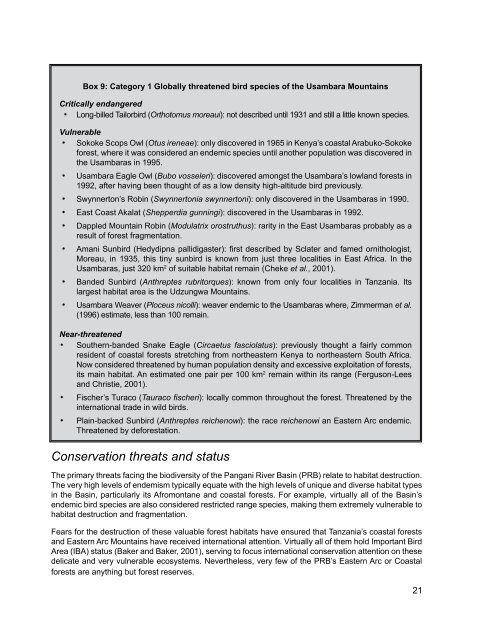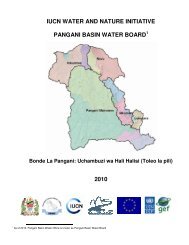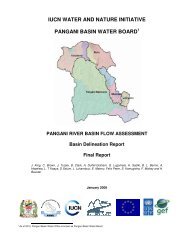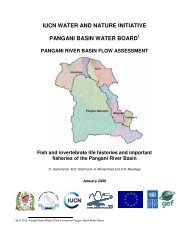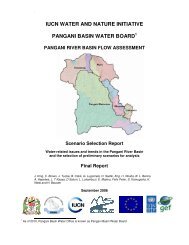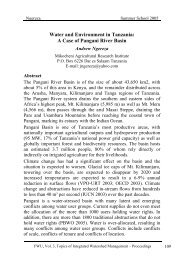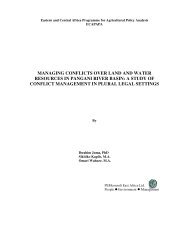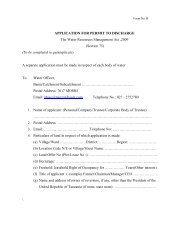PANGANI BASIN WATER BOARD
PANGANI BASIN WATER BOARD
PANGANI BASIN WATER BOARD
Create successful ePaper yourself
Turn your PDF publications into a flip-book with our unique Google optimized e-Paper software.
Box 9: Category 1 Globally threatened bird species of the Usambara Mountains<br />
Critically endangered<br />
• Long-billed Tailorbird (Orthotomus moreaui): not described until 1931 and still a little known species.<br />
Vulnerable<br />
• Sokoke Scops Owl (Otus ireneae): only discovered in 1965 in Kenya’s coastal Arabuko-Sokoke<br />
forest, where it was considered an endemic species until another population was discovered in<br />
the Usambaras in 1995.<br />
• Usambara Eagle Owl (Bubo vosseleri): discovered amongst the Usambara’s lowland forests in<br />
1992, after having been thought of as a low density high-altitude bird previously.<br />
• Swynnerton’s Robin (Swynnertonia swynnertoni): only discovered in the Usambaras in 1990.<br />
• East Coast Akalat (Shepperdia gunningi): discovered in the Usambaras in 1992.<br />
• Dappled Mountain Robin (Modulatrix orostruthus): rarity in the East Usambaras probably as a<br />
result of forest fragmentation.<br />
• Amani Sunbird (Hedydipna pallidigaster): first described by Sclater and famed ornithologist,<br />
Moreau, in 1935, this tiny sunbird is known from just three localities in East Africa. In the<br />
Usambaras, just 320 km 2 of suitable habitat remain (Cheke et al., 2001).<br />
• Banded Sunbird (Anthreptes rubritorques): known from only four localities in Tanzania. Its<br />
largest habitat area is the Udzungwa Mountains.<br />
• Usambara Weaver (Ploceus nicolli): weaver endemic to the Usambaras where, Zimmerman et al.<br />
(1996) estimate, less than 100 remain.<br />
Near-threatened<br />
• Southern-banded Snake Eagle (Circaetus fasciolatus): previously thought a fairly common<br />
resident of coastal forests stretching from northeastern Kenya to northeastern South Africa.<br />
Now considered threatened by human population density and excessive exploitation of forests,<br />
its main habitat. An estimated one pair per 100 km 2 remain within its range (Ferguson-Lees<br />
and Christie, 2001).<br />
• Fischer’s Turaco (Tauraco fischeri): locally common throughout the forest. Threatened by the<br />
international trade in wild birds.<br />
• Plain-backed Sunbird (Anthreptes reichenowi): the race reichenowi an Eastern Arc endemic.<br />
Threatened by deforestation.<br />
Conservation threats and status<br />
The primary threats facing the biodiversity of the Pangani River Basin (PRB) relate to habitat destruction.<br />
The very high levels of endemism typically equate with the high levels of unique and diverse habitat types<br />
in the Basin, particularly its Afromontane and coastal forests. For example, virtually all of the Basin’s<br />
endemic bird species are also considered restricted range species, making them extremely vulnerable to<br />
habitat destruction and fragmentation.<br />
Fears for the destruction of these valuable forest habitats have ensured that Tanzania’s coastal forests<br />
and Eastern Arc Mountains have received international attention. Virtually all of them hold Important Bird<br />
Area (IBA) status (Baker and Baker, 2001), serving to focus international conservation attention on these<br />
delicate and very vulnerable ecosystems. Nevertheless, very few of the PRB’s Eastern Arc or Coastal<br />
forests are anything but forest reserves.<br />
21


